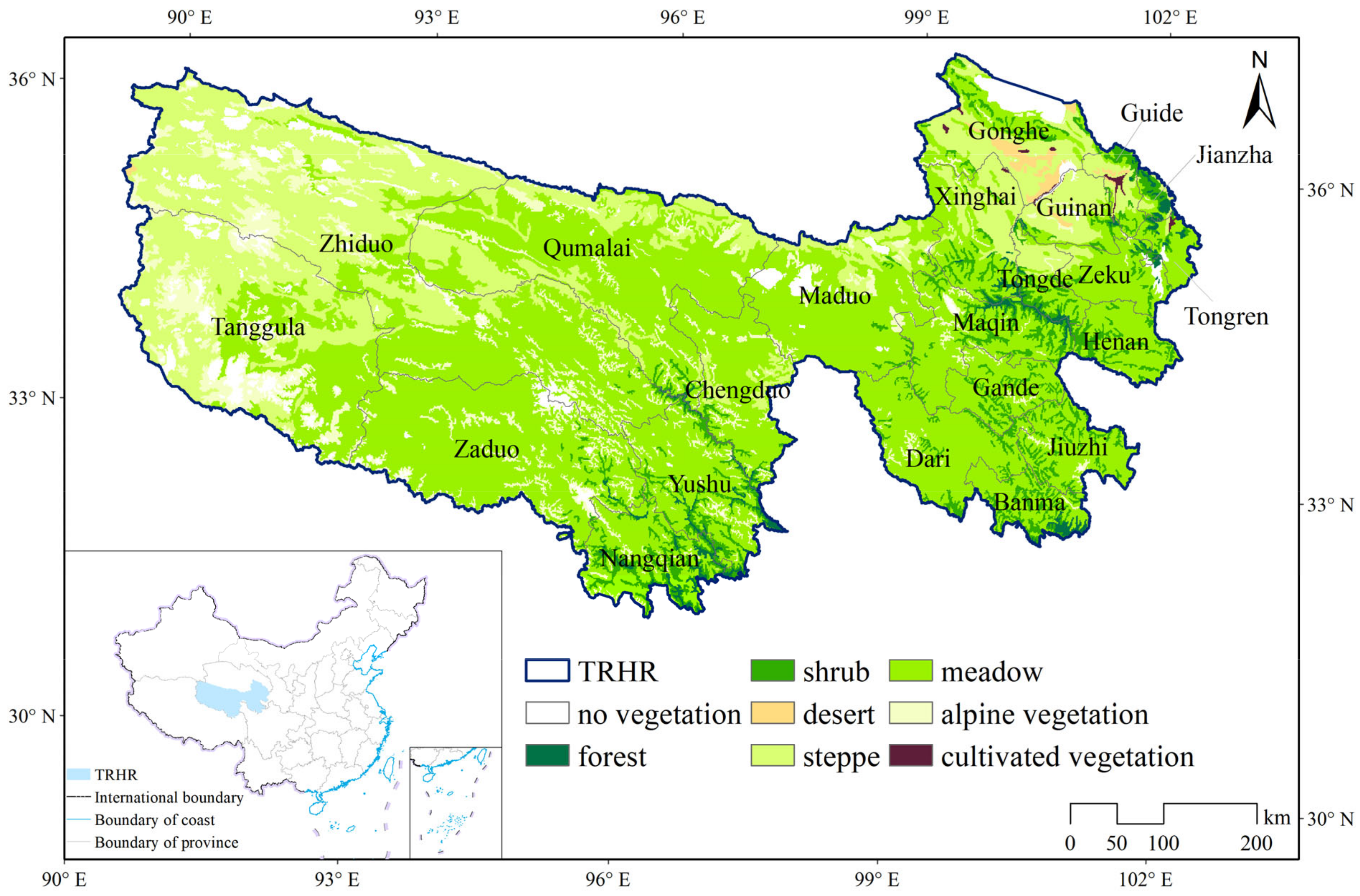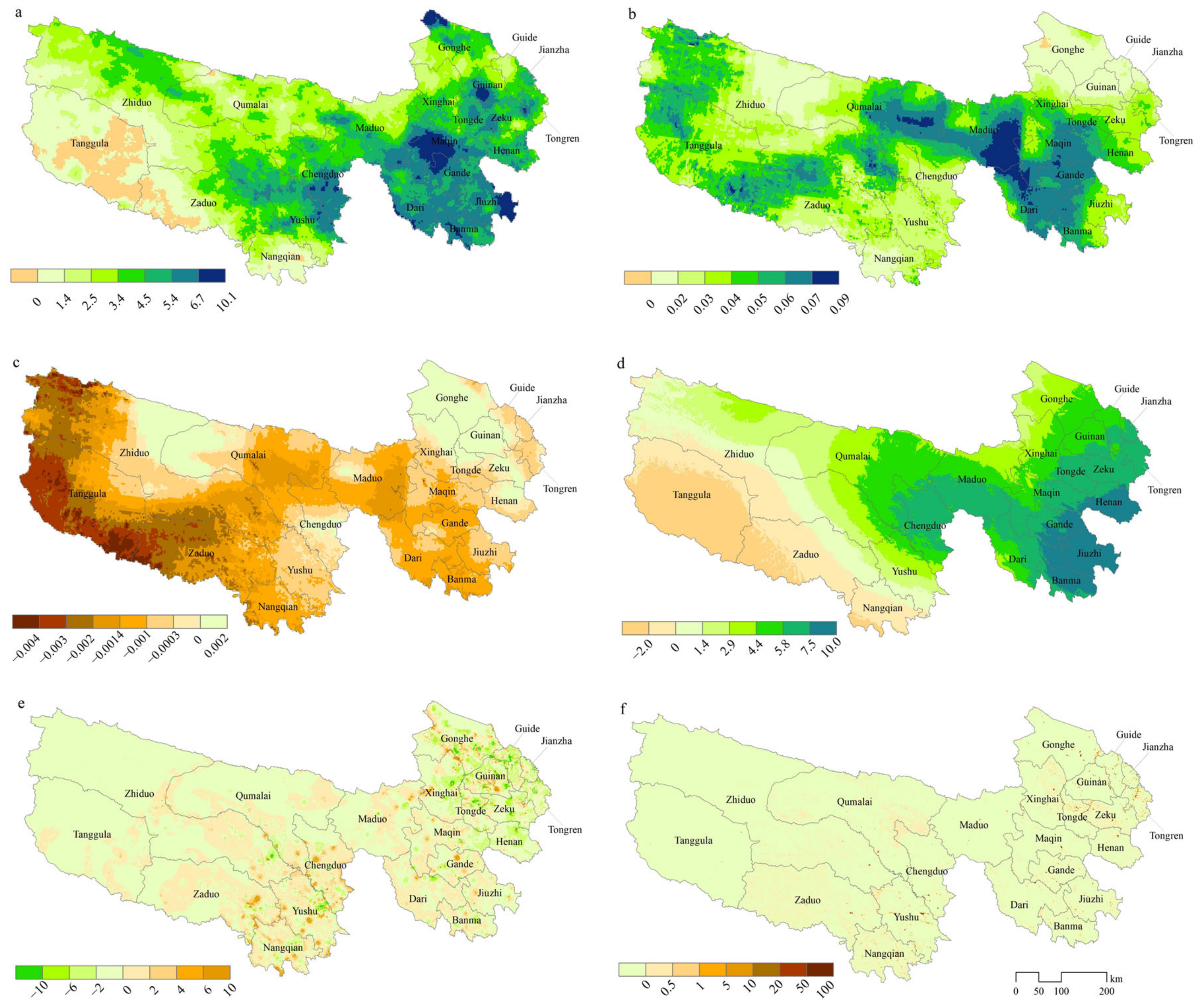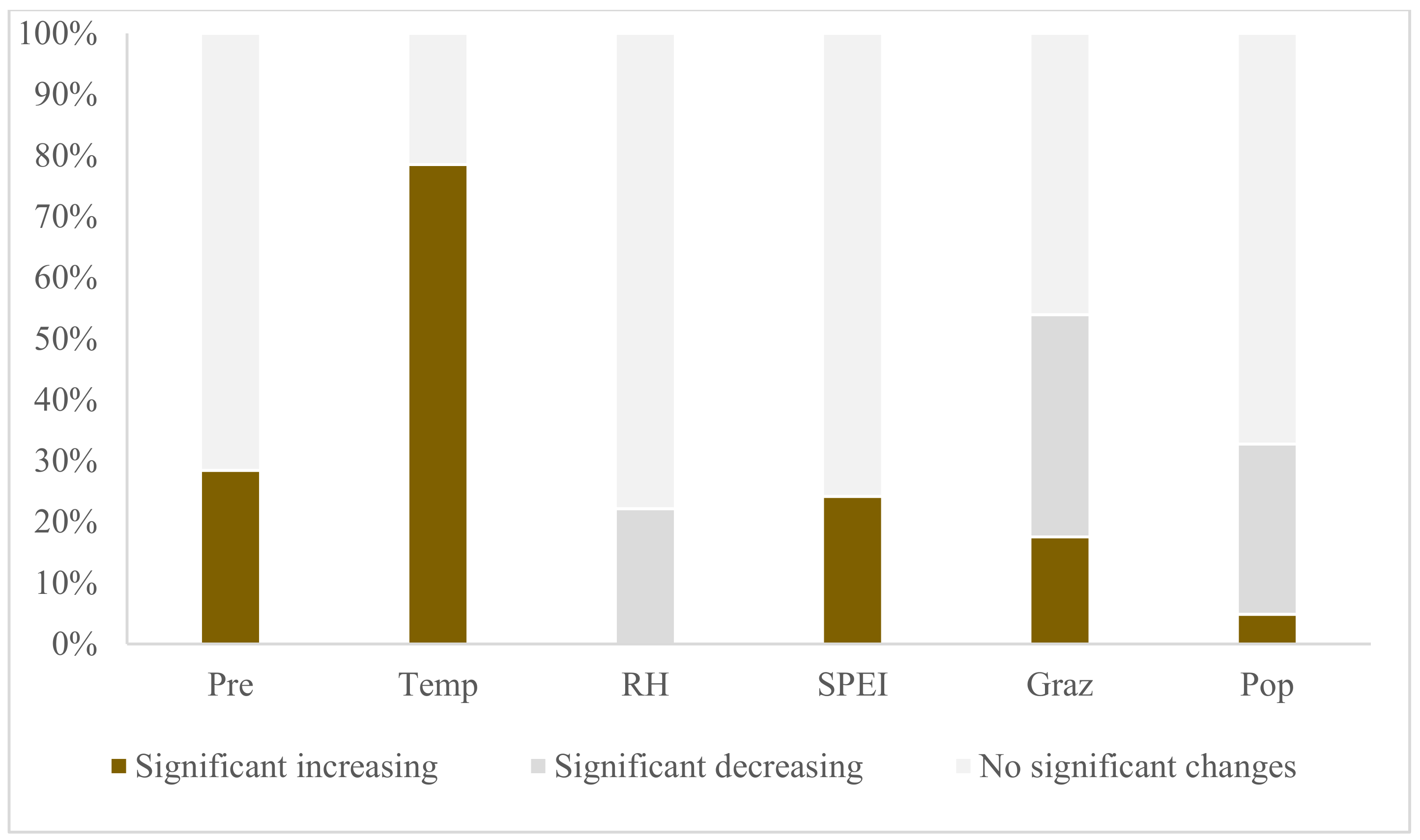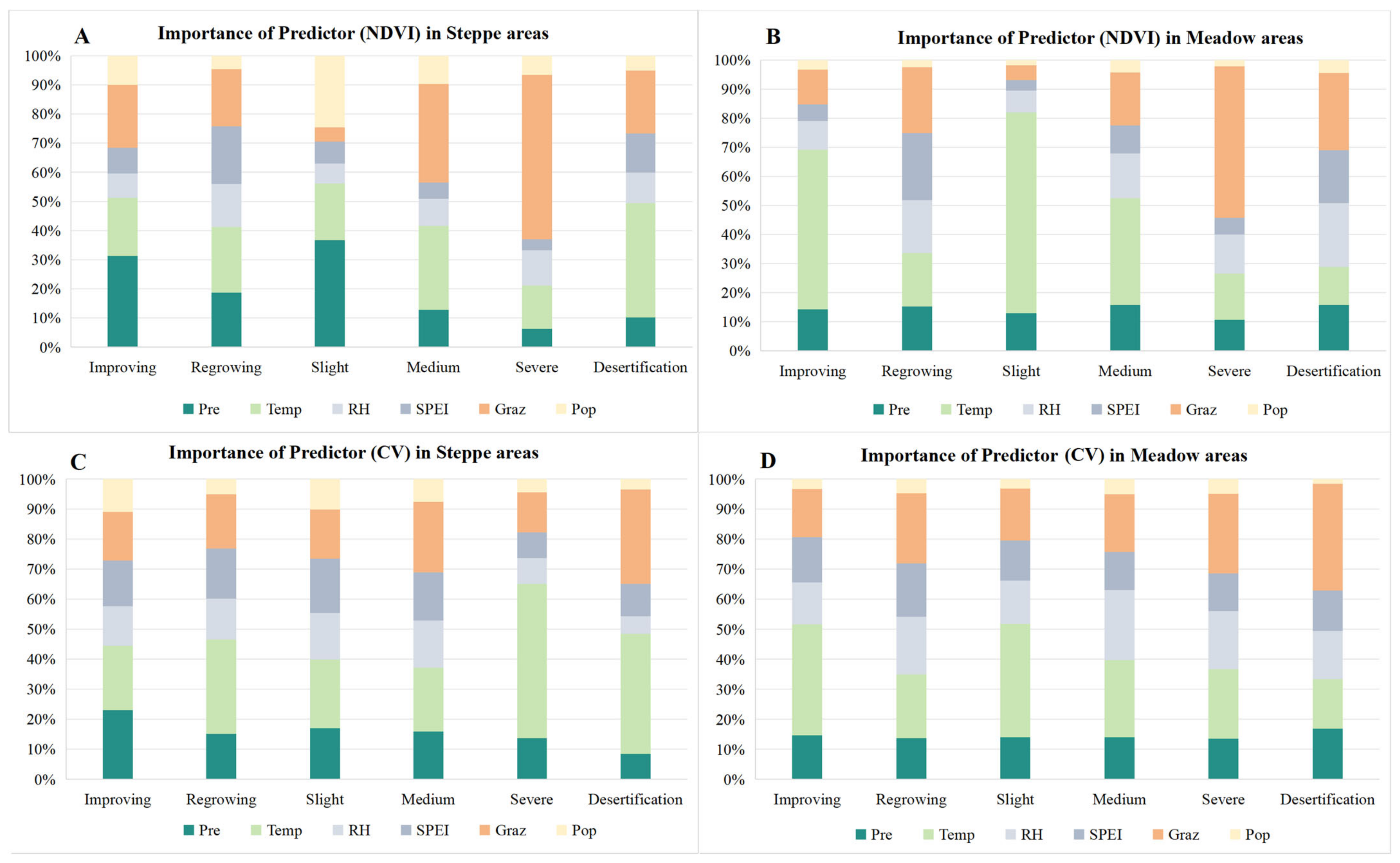An Assessment of Vegetation Changes in the Three-River Headwaters Region, China: Integrating NDVI and Its Spatial Heterogeneity
Abstract
1. Introduction
2. Materials and Methods
2.1. Study Area
2.2. Data Gathering and Processing
2.3. Methods
2.3.1. Spatial Heterogeneity and Its Changes
2.3.2. Classification of Vegetation Changes
2.3.3. Driving Factors Analysis
3. Results
3.1. Classification of Vegetation Changes by Integrating NDVI and Its Spatial Heterogeneity
3.1.1. Linear Trend in NDVI
3.1.2. Linear Trend in NDVI’s Spatial Heterogeneity
3.1.3. Refined Classification of Vegetation Improvement and Degradation
3.2. Variations and Contributions in Different Driving Factors
3.2.1. The Varying Trends in Multiple Influence Factors
3.2.2. Correlative Analysis of NDVI and Its Spatial Heterogeneity with Influencing Factors
3.2.3. Feature Importance of Various Influence Factors to NDVI and Its Spatial Heterogeneity
4. Discussion
4.1. Integrate Spatial Heterogeneity into Vegetation Dynamics Assessment
4.2. Influencing Factors of Vegetation Changes and Suggestions for Ecosystem Management
4.3. Limitation
5. Conclusions
Supplementary Materials
Author Contributions
Funding
Data Availability Statement
Conflicts of Interest
References
- Seddon, A.W.R.; Macias-Fauria, M.; Long, P.R.; Benz, D.; Willis, K.J. Sensitivity of global terrestrial ecosystems to climate variability. Nature 2016, 531, 229–232. [Google Scholar] [CrossRef] [PubMed]
- Intergovernmental Panel on Climate Change (IPCC). Climate Change 2021: The Physical Science Basis; Cambridge University Press: Cambridge, UK; New York, NY, USA, 2023; p. 2391. [Google Scholar]
- Berdugo, M.; Kéfi, S.; Soliveres, S.; Maestre, F.T. Plant spatial patterns identify alternative ecosystem multifunctionality states in global drylands. Nat. Ecol. Evol. 2017, 1, 0003. [Google Scholar] [CrossRef] [PubMed]
- Chen, J.; Yi, S.; Qin, Y. The contribution of plateau pika disturbance and erosion on patchy alpine grassland soil on the Qinghai-Tibetan Plateau: Implications for grassland restoration. Geoderma 2017, 297, 1–9. [Google Scholar] [CrossRef]
- Cai, H.; Yang, X.; Xu, X. Human-induced grassland degradation/restoration in the central Tibetan Plateau: The effects of ecological protection and restoration projects. Ecol. Eng. 2015, 83, 112–119. [Google Scholar] [CrossRef]
- Wang, P.; Lassoie, J.P.; Morreale, S.J.; Dong, S. A critical review of socioeconomic and natural factors in ecological degradation on the Qinghai-Tibetan Plateau, China. Rangel. J. 2015, 37, 1–9. [Google Scholar] [CrossRef]
- Bestelmeyer, B.T.; Duniway, M.C.; James, D.K.; Burkett, L.M.; Havstad, K.M. A test of critical thresholds and their indicators in a desertification-prone ecosystem: More resilience than we thought. Ecol. Lett. 2013, 16, 339–345. [Google Scholar] [CrossRef]
- Li, C.; de Jong, R.; Schmid, B.; Wulf, H.; Schaepman, M.E. Changes in grassland cover and in its spatial heterogeneity indicate degradation on the Qinghai-Tibetan Plateau. Ecol. Indic. 2020, 119, 106641. [Google Scholar] [CrossRef]
- Kéfi, S.; Rietkerk, M.; Alados, C.L.; Pueyo, Y.; Papanastasis, V.P.; ElAich, A.; De Ruiter, P.C. Spatial vegetation patterns and imminent desertification in Mediterranean arid ecosystems. Nature 2007, 449, 213–217. [Google Scholar] [CrossRef]
- Kröpfl, A.I.; Cecchi, G.A.; Villasuso, N.M.; Distel, R.A. Degradation and recovery processes in semi-arid patchy rangelands of Northern Patagonia, Argentina. Land Degrad. Dev. 2013, 24, 393–399. [Google Scholar] [CrossRef]
- Sheffer, E.; von Hardenberg, J.; Yizhaq, H.; Shachak, M.; Meron, E. Emerged or imposed: A theory on the role of physical templates and self-organisation for vege-tation patchiness. Ecol. Lett. 2013, 16, 127–139. [Google Scholar] [CrossRef]
- Dai, L.; Tang, H.; Pan, Y.; Zhang, L. Assessment of ecosystem stability in the agro-pastoral transitional zone for local sustainable management: A case study in Duolun County, northern China. Ecol. Indic. 2024, 162, 112018. [Google Scholar] [CrossRef]
- Kéfi, S.; Guttal, V.; Brock, W.A.; Carpenter, S.R.; Ellison, A.M.; Livina, V.N.; Seekell, D.A.; Scheffer, M.; Van Nes, E.H.; Dakos, V. Early warning signals of ecological transitions: Methods for spatial patterns. PLoS ONE 2014, 9, 10–13. [Google Scholar] [CrossRef]
- Lin, Y.; Han, G.; Zhao, M.; Chang, S.X. Spatial vegetation patterns as early signs of desertification: A case study of a desert steppe in Inner Mongolia. China. Landsc. Ecol 2010, 25, 1519–1527. [Google Scholar] [CrossRef]
- Maestre, F.T.; Escudero, A. Is the patch size distribution of vegetation a suitable indicator of desertification processes? Ecology 2009, 90, 1729–1735. [Google Scholar] [CrossRef] [PubMed]
- Liu, J.Y.; Xu, X.L.; Shao, Q.Q. The spatial and temporal characteristics of gr-assland degradation in the Three-River Headwaters Region in Qinghai Province. Acta. Geogr. Sin 2008, 63, 364–376. (In Chinese) [Google Scholar]
- Li, X.L.; Perry, G.L.W.; Brierley, G.; Sun, H.Q.; Li, C.H.; Lu, G.X. Quantitative assessment of degradation classifications for degraded alpine meadows (Heitutan), Sanjiangyuan, western China. L. Degrad. Dev. 2014, 25, 417–427. [Google Scholar] [CrossRef]
- Shao, Q.Q.; Fan, J.W.; Liu, J.Y.; Huang, L.; Cao, W.; Xu, X.L.; Ge, J.S.; Wu, D.; Li, Z.Q.; Gun, G.L.; et al. Assessment on the effects of the first-stage ecological conserva-tion and restoration project in Sanjiangyuan region. Acta Geogr. Sin. 2016, 71, 3–20. (In Chinese) [Google Scholar]
- Xu, X.L.; Wang, L.; Li, J.; Cai, H.Y. Analysis of the grassland restoration trend and degradation situation in the “Three-River Headwaters” region since the implementation of the ecological project. J. Geo-Inf. Sci. 2017, 19, 50–58. (In Chinese) [Google Scholar]
- Zhang, Q.; Zhang, Y.; Yu, T.; Zhong, D. Primary driving factors of ecological environment system change based on directed weighted network illustrating with the Three-River Headwaters Region. Sci. Total Environ. 2024, 916, 170055. [Google Scholar] [CrossRef]
- Han, Z.; Song, W.; Deng, X.; Xu, X.L. Grassland ecosystem responses to climate change and human activities within the Three-River Headwaters region of China. Sci. Rep. 2018, 8, 9079. [Google Scholar] [CrossRef]
- Zhang, Y.; Zhang, C.; Wang, Z.; Chen, Y.; Gang, C.; An, R.; Li, J. Vegetation dynamics and its driving forces from climate change and human activities in the Three-River Source Region, China from 1982 to 2012. Sci. Total Environ. 2016, 563–564, 210–220. [Google Scholar] [CrossRef] [PubMed]
- Zhang, X.; Jin, X. Vegetation dynamics and responses to climate change and anthropogenic activities in the Three-River Headwaters Region, China. Ecol. Indic. 2021, 131, 108223. [Google Scholar] [CrossRef]
- Ning, X.; Zhu, N.; Liu, Y.; Wang, H. Quantifying impacts of climate and human activities on the grassland in the Three-River Headwater Region after two phases of Ecological Project. Geogr. Sustain. 2022, 3, 164–176. [Google Scholar] [CrossRef]
- Jiang, C.; Zhang, L. Effect of ecological restoration and climate change on ecosystems: A case study in the Three-Rivers Headwater Region, China. Environ. Monit. Assess 2016, 188, 382. [Google Scholar] [CrossRef]
- Sun, X.; Li, S.; Zhai, X.; Wei, X.; Yan, C. Ecosystem changes revealed by land cover in the three-river headwaters region of Qinghai, China (1990–2015). Res. Cold Arid. Reg. 2023, 15, 85–91. [Google Scholar] [CrossRef]
- Mahmood, R.; Jia, S.; Lv, A.; Zhu, W. A preliminary assessment of environmental flow in the three rivers’ source region, Qinghai Tibetan Plateau, China and suggestions. Ecol. Eng. 2020, 144, 105709. [Google Scholar] [CrossRef]
- Wang, K.; Xu, Q.; Li, T. Does recent climate warming drive spatiotemporal shifts in functioning of high-elevation hydrological systems? Sci. Total Environ. 2020, 719, 137507. [Google Scholar] [CrossRef]
- Gao, J.; Shi, Y.; Zhang, H.; Chen, X.; Zhang, W.; Shen, W.; Xiao, T.; Zhang, Y. China Regional 250 m Normalized Difference Vegetation Index Data Set (2000–2023). National Tibetan Plateau/Third Pole Environment Data Center. 2023. Available online: https://cstr.cn/18406.11.Terre.tpdc.300328 (accessed on 3 August 2024).
- The Editorial Committee of the Chinese Vegetation Map, Chinese Academy of Sciences. Vegetation Map of China at a Scale of 1:1,000,000, 1980. Institute of Botany, Chinese Academy of Sciences. 2019. Available online: https://data.casearth.cn/dataset/5c19a5680600cf2a3c557b6b (accessed on 2 August 2024).
- Haklay, M.; Weber, P. OpenStreet map: User-generated street maps. IEEE Pervasive Comput. 2008, 7, 12–18. [Google Scholar] [CrossRef]
- Shen, Y.P. National 1:250000 Three-Level River Basin Data Set. National Cryosphere Desert Data Center. 2019. Available online: http://www.ncdc.ac.cn/portal/metadata/4f518dc4-4963-4ab4-b7e0-b5feb49d53e0 (accessed on 2 August 2024).
- Yang, K.; Jiang, Y.; Tang, W.; He, J.; Shao, C.; Zhou, X.; Lu, H.; Chen, Y.; Li, X.; Shi, J. A High-Resolution Near-Surface Meteorological Forcing Dataset for the Third Pole Region (TPMFD, 1979–2022). National Tibetan Plateau/Third Pole Environment Data Center. 2023. Available online: https://cstr.cn/18406.11.Atmos.tpdc.300398 (accessed on 3 August 2024).
- He, Q.; Wang, M.; Liu, K. GPRChinaSPEI1km: High Spatial Resolution and Century-Long SPEI Datasets for China from 1901 to 2020 Generated by Machine Learning. Zenodo. 2023. Available online: https://zenodo.org/records/8312201 (accessed on 3 August 2024).
- Oak Ridge National Laboratory. LandScan Global Population Database. Oak Ridge, TN: Oak Ridge National Laboratory. 2024. Available online: https://landscan.ornl.gov/ (accessed on 3 August 2024).
- Liu, B.; Livestock Carrying State Estimation Product in Qinghai-Tibet Plateau (2000–2019). National Tibetan Plateau/Third Pole Environment Data Center. 2019. Available online: https://cstr.cn/18406.11.Ecolo.tpdc.271512 (accessed on 3 August 2024).
- Xu, X.L.; Liu, J.Y.; Zhang, S.W.; Li, R.D.; Yan, C.Z.; Wu, S.X. China Multi-Period Land Use Remote Sensing Monitoring Dataset (CNLUCC). The Resource and Environmental Science Data Registration and Publication System. 2018. Available online: https://www.resdc.cn/DOI/doi.aspx?DOIid=54 (accessed on 2 August 2024). [CrossRef]
- Piao, S.; Fang, J.; Liu, H.; Zhu, B. NDVI-indicated decline in desertification in China in the past two decades. Geophys. Res. Lett. 2005, 32, 1–4. [Google Scholar] [CrossRef]
- Piao, S.; Wang, X.; Ciais, P.; Zhu, B.; Wang, T.; Liu, J. Changes in satellite-derived vegetation growth trend in temperate and boreal Eurasia from 1982 to 2006. Glob. Change Biol. 2011, 17, 3228–3239. [Google Scholar] [CrossRef]
- Zhang, G.; Zhang, Y.; Dong, J.; Xiao, X. Green-up dates in the Tibetan Plateau have continuously advanced from 1982 to 2011. Proc. Natl. Acad. Sci. USA 2013, 110, 4309–4314. [Google Scholar] [CrossRef] [PubMed]
- Wang, Z.; Zhang, Y.; Yang, Y.; Zhou, W.; Gang, C.; Zhang, Y.; Li, J.; An, R.; Wang, K.; Odeh, I.; et al. Quantitative assess the driving forces on the grassland degradation in the Qinghai–Tibet Plateau, in China. Ecol. Inform. 2016, 33, 32–44. [Google Scholar] [CrossRef]
- Fan, J.W.; Shao, Q.Q.; Liu, J.Y.; Wang, J.B.; Harris, W.; Chen, Z.Q.; Zhong, H.P.; Xu, X.L.; Liu, R.G. Assessment of effects of climate change and grazing activity on grassland yield in the Three Rivers Headwaters Region of Qinghai-Tibet Plateau. China. Environ. Monit. Assess. 2010, 170, 571–584. [Google Scholar] [CrossRef] [PubMed]
- Xu, W.; Gu, S.; Zhao, X.Q.; Xiao, J.; Tang, Y.; Fang, J.; Zhang, J.; Jiang, S. High positive correlation between soil temperature and NDVI from 1982 to 2006 in alpine meadow of the Three-River Source Region on the Qinghai-Tibetan Plateau. Int. J. Appl. Earth Obs. Geoinf. 2011, 13, 528–535. [Google Scholar] [CrossRef]
- Sun, L.; Zhao, D.; Zhang, G.; Wu, X.; Yang, Y.; Wang, Z. Using SPOT VEGETATION for analyzing dynamic changes and influencing factors on vegetation restoration in the Three-River Headwaters Region in the last 20 years (2000–2019), China. Ecol. Eng. 2022, 183, 106742. [Google Scholar] [CrossRef]
- Miehe, G.; Schleuss, P.M.; Seeber, E.; Babel, W.; Biermann, T.; Braendle, M.; Chen, F.; Coners, H.; Foken, T.; Gerken, T.; et al. The Kobresia pygmaea ecosystem of the Tibetan highlands—Origin, functioning and degradation of the world’s largest pastoral alpine ecosystem. Sci. Total Environ. 2019, 648, 754–771. [Google Scholar] [CrossRef]
- Liu, X.F.; Zhang, J.S.; Zhu, X.F.; Pan, Y.Z.; Liu, Y.X.; Zhang, D.H.; Lin, Z.H. Spatiotemporal changes in vegetation coverage and its driving factors in the Three-River Headwaters Region during 2000–2011. J. Geogr. Sci. 2014, 24, 188–302. [Google Scholar] [CrossRef]
- Tait, L.W.; Schiel, D.R. Impacts of temperature on primary productivity and respiration in naturally structured macroalgal- assemblages. PLoS ONE 2013, 8, e74413. [Google Scholar] [CrossRef]
- Ziska, L.; Knowlton, K.; Rogers, C.; Dalan, D.; Tierney, N.; Elder, M.A.; Filley, W.; Shropshire, J.; Ford, L.B.; Hedberg, C.; et al. Recent warming by latitude associated with increased length of ragweed pollen season in central North America. Proc. Nat. Acad. Sci. USA 2011, 108, 4248–4251. [Google Scholar] [CrossRef]
- Wu, Z.; Dijkstra, P.; Koch, G.W.; Peñuelas, J.; Hungate, B.A. Responses of terrestrial ecosystems to temperature and precipitation change: A meta-analysis of experimental manipulation. Glob. Change Biol. 2011, 17, 927–942. [Google Scholar] [CrossRef]
- Li, Z.; Shen, Q.; Fan, W.; Dong, S.; Wang, Z.; Xu, Y.; Ma, T.; Cao, Y. Nature-based solutions vs. human-induced approaches for alpine grassland ecosystem: “climate-help” overwhelms “human act” to promote ecological restoration in the Three-River-Source Region of Qinghai–Tibet Plateau. Remote Sens. 2024, 16, 1156. [Google Scholar] [CrossRef]
- Chen, B.X.; Zhang, X.Z.; Sun, Y.F.; Wang, J.S.; He, Y.T. Alpine grassland fPAR change over the Northern Tibetan Plateau from 2002 to 2011. Adv. Climate Change Res. 2017, 8, 108–116. [Google Scholar] [CrossRef]
- Feng, Y.; Wu, J.; Zhang, J.; Zhang, X.; Song, C. Identifying the relative contributions of climate and grazing to both direction and magnitude of alpine grassland productivity dynamics from 1993 to 2011 on the northern Tibetan Plateau. Rem. Sens. 2017, 9, 136. [Google Scholar] [CrossRef]
- Bai, Y.; Guo, C.; Degen, A.A.; Ahmad, A.A.; Wang, W.; Zhang, T.; Li, W.; Ma, L.; Huang, M.; Zeng, H.; et al. Climate warming benefits alpine vegetation growth in Three-River Headwater Region, China. Sci. Total Environ. 2020, 742, 140574. [Google Scholar] [CrossRef] [PubMed]
- López-Juambeltz, F.; Rodríguez-Gallego, L.; Dabezíes, J.M.; Chreties, C.; Narbondo, S.; Conde, D. A GIS-based assessment combined with local ecological knowledge to support the management of Juncus acutus L. spreading in the floodplain of a protected coastal lagoon. J. Nat. Conserv. 2020, 57, 125891. [Google Scholar] [CrossRef]







| Types of Ecosystem Change | Required Conditions |
|---|---|
| Desertification | NDVI < 0.2 and NDVI slope < 0 and CV slope < 0 |
| Severe degradation | NDVI > 0.2 and NDVI slope < 0 and CV slope < 0 |
| Medium degradation | NDVI slope < 0 and CV slope > 0 |
| Slight degradation | NDVI > 0.2 and NDVI slope > 0 and CV slope > 0 |
| Regrowing conditions | NDVI < 0.2 and NDVI slope > 0 and CV slope > 0 |
| Improving conditions | NDVI slope > 0 and CV slope < 0 |
| Name of the Correlation Coefficient | Proportion of Significantly Correlated Regions (%) | Proportion of Positively or Negatively Correlated Areas in All Significantly Correlated Regions (%) |
|---|---|---|
| NDVI-Pre | 40.1 | 98.9(+) |
| NDVI-Temp | 27.1 | 94.6(+) |
| NDVI-RH | 8.2 | 66.0(−) |
| NDVI-SPEI | 36.0 | 99.2(+) |
| NDVI-Graz | 24.6 | 71.5(−) |
| NDVI-Pop | 16.6 | 84.3(−) |
| CV-Pre | 18.4 | 82.0(−) |
| CV-Temp | 17.5 | 61.7(−) |
| CV-RH | 6.6 | 52.7(−) |
| CV-SPEI | 15.2 | 87.8(−) |
| CV-Graz | 22.5 | 50.4(+) |
| CV-Pop | 12.2 | 66.0(+) |
Disclaimer/Publisher’s Note: The statements, opinions and data contained in all publications are solely those of the individual author(s) and contributor(s) and not of MDPI and/or the editor(s). MDPI and/or the editor(s) disclaim responsibility for any injury to people or property resulting from any ideas, methods, instructions or products referred to in the content. |
© 2024 by the authors. Licensee MDPI, Basel, Switzerland. This article is an open access article distributed under the terms and conditions of the Creative Commons Attribution (CC BY) license (https://creativecommons.org/licenses/by/4.0/).
Share and Cite
Mou, X.; Chai, H.; Duan, C.; Feng, Y.; Wang, X. An Assessment of Vegetation Changes in the Three-River Headwaters Region, China: Integrating NDVI and Its Spatial Heterogeneity. Plants 2024, 13, 2814. https://doi.org/10.3390/plants13192814
Mou X, Chai H, Duan C, Feng Y, Wang X. An Assessment of Vegetation Changes in the Three-River Headwaters Region, China: Integrating NDVI and Its Spatial Heterogeneity. Plants. 2024; 13(19):2814. https://doi.org/10.3390/plants13192814
Chicago/Turabian StyleMou, Xuejie, Huixia Chai, Cheng Duan, Yao Feng, and Xiahui Wang. 2024. "An Assessment of Vegetation Changes in the Three-River Headwaters Region, China: Integrating NDVI and Its Spatial Heterogeneity" Plants 13, no. 19: 2814. https://doi.org/10.3390/plants13192814
APA StyleMou, X., Chai, H., Duan, C., Feng, Y., & Wang, X. (2024). An Assessment of Vegetation Changes in the Three-River Headwaters Region, China: Integrating NDVI and Its Spatial Heterogeneity. Plants, 13(19), 2814. https://doi.org/10.3390/plants13192814






